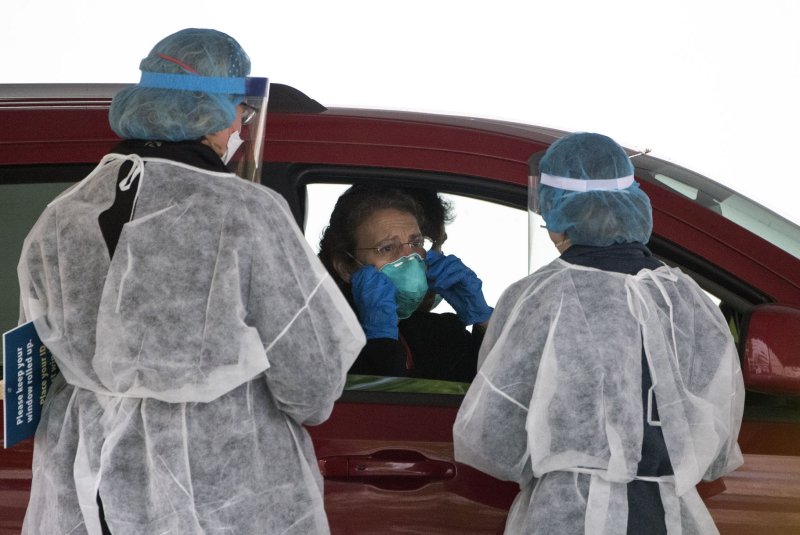Healthcare workers with George Washington University Hospital talk to a patient before administering a COVID-19 test during the coronavirus pandemic in Washington, D.C., in April. Photo by Kevin Dietsch/UPI |
License Photo
May 6 (UPI) -- Communities across the United States still need to expand hospital capacity to manage new COVID-19 cases, even as some states loosen social distancing restrictions, a study published Wednesday by JAMA Network Open says.
The analysis, performed by researchers at Harvard T.H. Chan School of Public Health and Johns Hopkins Bloomberg School of Public Health, estimates that some U.S. cities could need as many as 4.4 intensive care units per 10,000 adults to manage critically ill patients with the disease caused by the new coronavirus, SARS-CoV-2.
The figures are based on a "Wuhan-like" outbreak, the authors said, referring to the Chinese city where the global pandemic began.
For a city like Los Angeles, which has nearly 28,000 confirmed cases of the virus, with nearly 1,600 new diagnoses on Tuesday according to Johns Hopkins University, an outbreak of that magnitude could be particularly problematic.
The California Health Care Foundation estimates that Los Angeles County has just over 2,100 ICU beds.
"Even after the lockdown of Wuhan on Jan. 23, the number of seriously ill COVID-19 patients continued to rise, exceeding local hospitalization and ICU capacities for at least a month," study co-author Ruoran Li, a doctoral student at Harvard T. H. Chan, told UPI on Wednesday.
"Without efforts to slow the spread of the virus, hospitals, especially ICU beds in major cities around the U.S., will likely be overwhelmed," he said.
The United States has more than 1.2 million confirmed cases of COVID-19, and more than 71,000 related deaths to date, according to Johns Hopkins. As many as 20 percent of those with the virus become seriously ill and require critical care in a hospital ICU, medical experts have said.
Community hospitals nationally have fewer than 98,000 ICU beds, including roughly 23,000 allocated for newborns, according to the American Hospital Association. A 2014 study published in the journal Critical Care Medicine found that as many as 80 percent of those beds normally are occupied at any given time.
For the analysis, Li and her colleagues analyzed the ICU bed needs in two Chinese cities, Wuhan and Guangzhou, at the peak of the COVID-19 outbreaks in each.
They then developed estimates on ICU bed needs in the United States, based on the adult population, factoring in the prevalence of high blood pressure, as well as age, both of which have been linked to more severe illness.
In Wuhan, at the peak of the outbreak, more than 2,000 adults with the virus required ICU care daily at the peak of the outbreak, the researchers found. This translated to a need for 2.6 ICU beds per 10,000 adults in the general population.
On average, COVID-19 patients in the city accounted for 429 ICU patients and 1,521 patients admitted to the hospital in serious condition daily.
Overall, at the epidemic's peak, 19,425 patients -- or 24.5 per 10,000 adults in the general population -- were hospitalized, with 9,689 -- or 12.2 per 10,000 adults in the general population -- in serious condition.
Despite implementing strict disease control measures in both cities, which restricted travel into and out of both and closed most businesses and public institutions, hospitals were overwhelmed with new cases of the disease in late January.
Chinese officials quickly built two new facilities dedicated to treating COVID-19 patients to address the overflow.
In Wuhan, restrictions were imposed on Jan. 23, when 500 COVID-19 cases existed in the city.
At peak demand for ICU beds, roughly four weeks later, the per capita need for beds was approximately "equal to the total number of ICU beds per capita in the United States, empty and full" -- which is approximately 2.8 per 10,000 adults in the general population, according to study co-author Marc Lipsitch, professor of epidemiology at the Harvard T.H. Chan School of Public Health.
In the United States, among adults with high blood pressure, as many as 9.5 per 10,000 in the general population per day could require critical care in the ICU, Li and her team estimated. More than 108 million U.S. adults have high blood pressure, according to the U.S. Centers for Disease Control and Prevention.
Similarly, among U.S. adults 65 years of age and older, as many as eight COVID-19 patients per 10,000 adults in the general population per day could require ICU care.
In comparison, among those younger than 65, and without high blood pressure, 1.2 to 1.3 COVID-19 patients per 10,000 adults in the general population per day could need an ICU bed.
"The per case risk of needing intensive care and the risk for dying are extremely higher for COVID-19 than they are for the seasonal flu," Lipsitch said in a conference call with reporters in April, when the findings of the analysis first were made available.
"The data I've seen from China indicates that patients stay in intensive care for quite a long time with this disease, so it's not just the number of people in intensive care, but the duration of their stay" that could overwhelm the system, he said.















